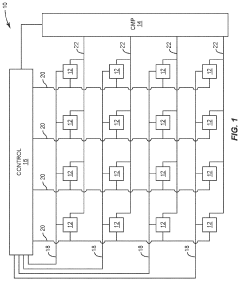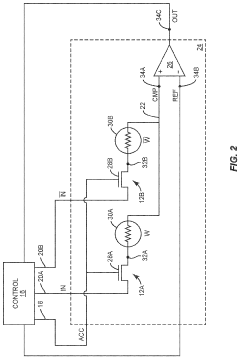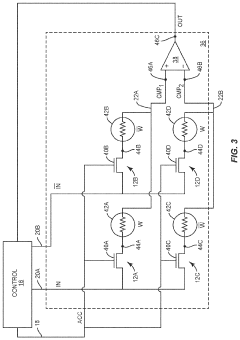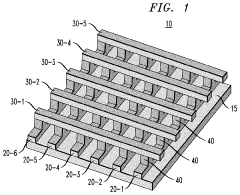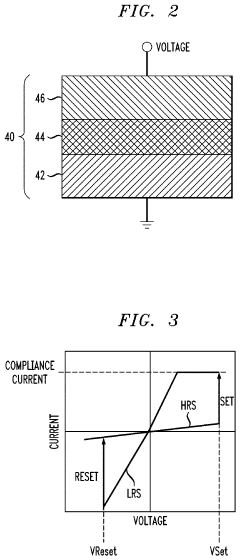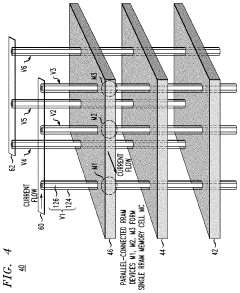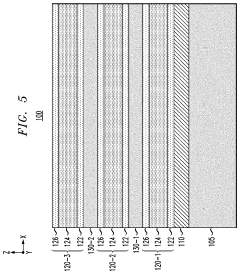RRAM vs Coherent Memory: Analysis of Scalability Metrics
SEP 10, 20259 MIN READ
Generate Your Research Report Instantly with AI Agent
Patsnap Eureka helps you evaluate technical feasibility & market potential.
RRAM and Coherent Memory Evolution Background
The evolution of memory technologies has been a critical factor in the advancement of computing systems over the past several decades. Resistive Random-Access Memory (RRAM) and Coherent Memory represent two significant paradigms in this evolutionary journey, each with distinct characteristics and development trajectories.
RRAM emerged in the early 2000s as a promising non-volatile memory technology, building upon the foundations laid by earlier research into resistive switching phenomena observed in oxide materials during the 1960s. The fundamental breakthrough came with the demonstration of reliable resistive switching in metal-oxide structures, which opened the door to practical RRAM implementations. By 2008, major semiconductor companies had begun serious development efforts, recognizing RRAM's potential to overcome the scaling limitations of flash memory.
The evolution of RRAM has been characterized by progressive improvements in switching speed, endurance, and power consumption. Early RRAM cells suffered from high operating voltages and limited cycling capability, but advancements in materials science and device architecture have substantially addressed these limitations. The transition from binary to multi-level cell configurations marked a significant milestone, enabling higher storage densities and establishing RRAM as a viable contender in the storage hierarchy.
Coherent memory, meanwhile, has evolved along a different trajectory focused on addressing the challenges of maintaining data consistency across increasingly complex multi-processor systems. The concept gained prominence in the 1990s with the rise of symmetric multiprocessing architectures, where cache coherence protocols became essential for system functionality. The evolution from snooping-based protocols to directory-based approaches represented a critical advancement, particularly as processor counts increased.
The development of coherent memory systems has been closely tied to the evolution of interconnect technologies and system architectures. The transition from bus-based to point-to-point interconnects enabled more scalable coherence mechanisms, while the emergence of non-uniform memory access (NUMA) architectures necessitated more sophisticated coherence protocols to manage the varying access latencies.
Recent years have seen increasing convergence between these previously distinct memory paradigms. The integration of non-volatile memory technologies like RRAM into coherent memory hierarchies has become an active area of research, driven by the need for energy-efficient computing and the growing importance of data persistence. This convergence has been facilitated by advances in interface standards and memory controllers capable of managing heterogeneous memory resources.
The historical evolution of both technologies reveals a consistent pattern of addressing fundamental trade-offs between performance, power consumption, and scalability. Understanding this evolutionary context is essential for evaluating the current state of these technologies and projecting their future development paths in the context of emerging computing paradigms.
RRAM emerged in the early 2000s as a promising non-volatile memory technology, building upon the foundations laid by earlier research into resistive switching phenomena observed in oxide materials during the 1960s. The fundamental breakthrough came with the demonstration of reliable resistive switching in metal-oxide structures, which opened the door to practical RRAM implementations. By 2008, major semiconductor companies had begun serious development efforts, recognizing RRAM's potential to overcome the scaling limitations of flash memory.
The evolution of RRAM has been characterized by progressive improvements in switching speed, endurance, and power consumption. Early RRAM cells suffered from high operating voltages and limited cycling capability, but advancements in materials science and device architecture have substantially addressed these limitations. The transition from binary to multi-level cell configurations marked a significant milestone, enabling higher storage densities and establishing RRAM as a viable contender in the storage hierarchy.
Coherent memory, meanwhile, has evolved along a different trajectory focused on addressing the challenges of maintaining data consistency across increasingly complex multi-processor systems. The concept gained prominence in the 1990s with the rise of symmetric multiprocessing architectures, where cache coherence protocols became essential for system functionality. The evolution from snooping-based protocols to directory-based approaches represented a critical advancement, particularly as processor counts increased.
The development of coherent memory systems has been closely tied to the evolution of interconnect technologies and system architectures. The transition from bus-based to point-to-point interconnects enabled more scalable coherence mechanisms, while the emergence of non-uniform memory access (NUMA) architectures necessitated more sophisticated coherence protocols to manage the varying access latencies.
Recent years have seen increasing convergence between these previously distinct memory paradigms. The integration of non-volatile memory technologies like RRAM into coherent memory hierarchies has become an active area of research, driven by the need for energy-efficient computing and the growing importance of data persistence. This convergence has been facilitated by advances in interface standards and memory controllers capable of managing heterogeneous memory resources.
The historical evolution of both technologies reveals a consistent pattern of addressing fundamental trade-offs between performance, power consumption, and scalability. Understanding this evolutionary context is essential for evaluating the current state of these technologies and projecting their future development paths in the context of emerging computing paradigms.
Market Demand Analysis for Next-Generation Memory Technologies
The memory technology market is experiencing unprecedented growth driven by emerging applications in artificial intelligence, edge computing, Internet of Things (IoT), and high-performance computing. Current projections indicate the next-generation memory market will reach $36 billion by 2025, with a compound annual growth rate of 29% from 2020. This accelerated demand stems from traditional memory technologies approaching their physical limitations while application requirements continue to escalate.
RRAM (Resistive Random Access Memory) and Coherent Memory technologies represent two promising solutions addressing different segments of this expanding market. RRAM has garnered significant attention due to its non-volatile nature, low power consumption, and potential for high-density storage. Market research indicates RRAM could capture 18% of the emerging memory market by 2026, particularly in edge computing applications where power efficiency is paramount.
Coherent memory systems, focusing on maintaining data consistency across distributed computing environments, address the growing demand for seamless data sharing in complex computing architectures. This technology segment is projected to grow at 34% annually through 2025, driven primarily by data center applications and high-performance computing environments.
The automotive sector represents a rapidly expanding market for both technologies, with advanced driver-assistance systems and autonomous vehicles requiring both the non-volatile characteristics of RRAM and the coherency benefits of coherent memory systems. Industry forecasts suggest automotive memory requirements will triple by 2027, creating a $5.2 billion opportunity specifically for next-generation solutions.
Enterprise storage systems present another substantial market, with organizations increasingly seeking scalable memory solutions that balance performance, power efficiency, and cost. The enterprise segment currently values memory scalability metrics above all other factors, with 76% of IT decision-makers citing scalability as their primary consideration when evaluating new memory technologies.
Consumer electronics continues to drive volume demand, though with greater price sensitivity. Smartphone manufacturers are particularly interested in RRAM's potential to extend battery life while maintaining performance, with analysts predicting adoption in premium devices beginning in 2024.
The geographical distribution of demand shows Asia-Pacific leading with 42% market share, followed by North America (31%) and Europe (21%). China's aggressive investments in semiconductor technology have created particularly strong regional demand for advanced memory solutions that can scale effectively across various application domains.
RRAM (Resistive Random Access Memory) and Coherent Memory technologies represent two promising solutions addressing different segments of this expanding market. RRAM has garnered significant attention due to its non-volatile nature, low power consumption, and potential for high-density storage. Market research indicates RRAM could capture 18% of the emerging memory market by 2026, particularly in edge computing applications where power efficiency is paramount.
Coherent memory systems, focusing on maintaining data consistency across distributed computing environments, address the growing demand for seamless data sharing in complex computing architectures. This technology segment is projected to grow at 34% annually through 2025, driven primarily by data center applications and high-performance computing environments.
The automotive sector represents a rapidly expanding market for both technologies, with advanced driver-assistance systems and autonomous vehicles requiring both the non-volatile characteristics of RRAM and the coherency benefits of coherent memory systems. Industry forecasts suggest automotive memory requirements will triple by 2027, creating a $5.2 billion opportunity specifically for next-generation solutions.
Enterprise storage systems present another substantial market, with organizations increasingly seeking scalable memory solutions that balance performance, power efficiency, and cost. The enterprise segment currently values memory scalability metrics above all other factors, with 76% of IT decision-makers citing scalability as their primary consideration when evaluating new memory technologies.
Consumer electronics continues to drive volume demand, though with greater price sensitivity. Smartphone manufacturers are particularly interested in RRAM's potential to extend battery life while maintaining performance, with analysts predicting adoption in premium devices beginning in 2024.
The geographical distribution of demand shows Asia-Pacific leading with 42% market share, followed by North America (31%) and Europe (21%). China's aggressive investments in semiconductor technology have created particularly strong regional demand for advanced memory solutions that can scale effectively across various application domains.
Current Technical Challenges in Memory Scalability
Memory scalability faces significant technical challenges as traditional architectures approach their physical limits. The semiconductor industry's reliance on Moore's Law has encountered fundamental barriers in recent years, particularly for memory technologies. Both RRAM (Resistive Random-Access Memory) and coherent memory systems exhibit distinct scalability constraints that impact their viability for next-generation computing systems.
For RRAM technologies, the primary scalability challenges include resistance drift over time, which compromises long-term data retention. As cell dimensions shrink below 10nm, quantum tunneling effects become increasingly problematic, leading to higher leakage currents and reduced reliability. Additionally, the sneak path current issue in crossbar arrays limits the practical density achievable without incorporating selector devices, which adds complexity and manufacturing costs.
Coherent memory systems face different scalability hurdles, predominantly centered around maintaining cache coherence across increasingly large and distributed systems. The directory-based protocols commonly employed become bandwidth-intensive as system size grows, creating bottlenecks that limit overall performance scaling. The coherence traffic overhead increases non-linearly with core count, resulting in diminishing returns for large-scale systems.
Power consumption represents a critical challenge for both technologies. RRAM requires significant current for switching operations, particularly during the SET process, which becomes problematic as device density increases. For coherent memory systems, the energy cost of maintaining coherence across distributed nodes grows substantially with system scale, threatening to exceed power budgets in large deployments.
Manufacturing consistency poses another significant barrier. RRAM devices exhibit considerable cell-to-cell and cycle-to-cycle variability, which worsens at smaller geometries. This variability necessitates more sophisticated error correction mechanisms, reducing effective capacity and increasing system complexity. Coherent memory systems struggle with manufacturing variations across different memory controllers and interconnects, requiring extensive validation and potentially limiting yield.
Latency characteristics also present scaling challenges. While RRAM offers promising access times, the peripheral circuitry required for addressing and sensing introduces delays that don't scale proportionally with device size reduction. Coherent memory systems face increasing latency penalties as system size grows, particularly for remote memory accesses that must traverse multiple coherence domains.
Integration with existing memory hierarchies remains problematic for both technologies. RRAM's unique characteristics require specialized controllers and interfaces that may not seamlessly integrate with conventional memory subsystems. Similarly, extending coherence protocols to accommodate heterogeneous memory types introduces complexity that can undermine scalability benefits.
For RRAM technologies, the primary scalability challenges include resistance drift over time, which compromises long-term data retention. As cell dimensions shrink below 10nm, quantum tunneling effects become increasingly problematic, leading to higher leakage currents and reduced reliability. Additionally, the sneak path current issue in crossbar arrays limits the practical density achievable without incorporating selector devices, which adds complexity and manufacturing costs.
Coherent memory systems face different scalability hurdles, predominantly centered around maintaining cache coherence across increasingly large and distributed systems. The directory-based protocols commonly employed become bandwidth-intensive as system size grows, creating bottlenecks that limit overall performance scaling. The coherence traffic overhead increases non-linearly with core count, resulting in diminishing returns for large-scale systems.
Power consumption represents a critical challenge for both technologies. RRAM requires significant current for switching operations, particularly during the SET process, which becomes problematic as device density increases. For coherent memory systems, the energy cost of maintaining coherence across distributed nodes grows substantially with system scale, threatening to exceed power budgets in large deployments.
Manufacturing consistency poses another significant barrier. RRAM devices exhibit considerable cell-to-cell and cycle-to-cycle variability, which worsens at smaller geometries. This variability necessitates more sophisticated error correction mechanisms, reducing effective capacity and increasing system complexity. Coherent memory systems struggle with manufacturing variations across different memory controllers and interconnects, requiring extensive validation and potentially limiting yield.
Latency characteristics also present scaling challenges. While RRAM offers promising access times, the peripheral circuitry required for addressing and sensing introduces delays that don't scale proportionally with device size reduction. Coherent memory systems face increasing latency penalties as system size grows, particularly for remote memory accesses that must traverse multiple coherence domains.
Integration with existing memory hierarchies remains problematic for both technologies. RRAM's unique characteristics require specialized controllers and interfaces that may not seamlessly integrate with conventional memory subsystems. Similarly, extending coherence protocols to accommodate heterogeneous memory types introduces complexity that can undermine scalability benefits.
Comparative Analysis of RRAM and Coherent Memory Architectures
01 RRAM Architecture and Design for Scalability
Resistive Random Access Memory (RRAM) architectures are designed with specific features to enhance scalability. These designs include innovative cell structures, array configurations, and integration techniques that allow for higher density memory solutions. The architecture focuses on minimizing cell size while maintaining performance, addressing challenges like sneak path currents and ensuring reliable switching behavior across large arrays. These architectural innovations are fundamental to achieving coherent memory systems that can scale effectively.- RRAM architecture and design for scalability: Resistive Random Access Memory (RRAM) architectures can be designed with specific features to enhance scalability. These designs include multi-layer structures, cross-point arrays, and innovative cell configurations that allow for higher density memory integration. The architecture considerations focus on minimizing cell size while maintaining performance characteristics, enabling greater memory capacity in smaller footprints. These approaches address fundamental scaling challenges in memory technology by optimizing the physical layout and electrical properties of RRAM cells.
- Coherent memory systems and performance metrics: Coherent memory systems maintain data consistency across multiple processing elements and memory hierarchies. Key performance metrics for these systems include access latency, bandwidth utilization, and cache coherence protocol efficiency. These metrics are essential for evaluating the scalability of memory systems in multi-core and distributed computing environments. Coherent memory architectures employ specialized controllers and protocols to manage data consistency while optimizing for performance, particularly as system scale increases.
- Integration of RRAM in memory hierarchies: RRAM can be integrated into various levels of the memory hierarchy to leverage its unique characteristics. This integration involves placing RRAM cells strategically between traditional DRAM and storage layers, creating hybrid memory systems that optimize for both performance and capacity. The integration approaches focus on utilizing RRAM's non-volatility, lower power consumption, and density advantages while mitigating its limitations such as write endurance. These hybrid architectures can significantly improve overall system scalability by balancing performance requirements across different memory technologies.
- Scalability metrics and evaluation frameworks: Specific metrics and frameworks have been developed to evaluate memory scalability, particularly for emerging technologies like RRAM. These metrics include density scaling factors, energy efficiency measurements, retention characteristics, and performance under various workloads. Evaluation frameworks provide standardized methods for comparing different memory technologies and architectures, enabling objective assessment of their scalability potential. These metrics help identify bottlenecks and optimization opportunities in memory system designs as they scale to larger capacities and more complex configurations.
- Novel materials and fabrication techniques for RRAM scalability: Advanced materials and fabrication techniques are being developed to enhance RRAM scalability. These include novel switching materials, electrode compositions, and deposition methods that improve cell characteristics while enabling smaller feature sizes. Innovations in manufacturing processes allow for three-dimensional integration and multi-layer stacking, significantly increasing memory density. These material and process innovations address fundamental physical limitations in scaling conventional memory technologies, potentially enabling RRAM to achieve higher densities than traditional memory technologies while maintaining performance and reliability.
02 Coherent Memory Systems with RRAM Integration
Coherent memory systems incorporating RRAM technology utilize specific protocols and interfaces to maintain data consistency across multiple processing elements. These systems implement cache coherency protocols adapted for the unique characteristics of resistive memory, enabling efficient data sharing while minimizing overhead. The integration approaches focus on optimizing the interface between traditional memory hierarchies and RRAM components, addressing challenges related to different access patterns and latency characteristics to ensure system-wide coherence.Expand Specific Solutions03 Performance and Reliability Metrics for RRAM
Specific metrics have been developed to evaluate the performance and reliability of RRAM in coherent memory systems. These metrics include endurance measurements, retention characteristics, read/write latency, and power consumption profiles. Advanced testing methodologies assess how these parameters scale across different array sizes and under various operating conditions. The metrics provide standardized ways to compare different RRAM implementations and predict their behavior when scaled to larger capacities, helping to identify optimal configurations for specific applications.Expand Specific Solutions04 Scaling Techniques for RRAM Manufacturing
Manufacturing techniques specifically designed for scaling RRAM to higher densities include advanced deposition methods, precise control of switching layer thickness, and novel electrode materials. These techniques address challenges such as process variability and defect density that become more critical at smaller feature sizes. Innovations in 3D integration and multi-layer stacking allow for vertical scaling, significantly increasing memory density without expanding the footprint. These manufacturing approaches are essential for realizing the theoretical density advantages of RRAM technology.Expand Specific Solutions05 System-Level Optimization for Coherent RRAM
System-level optimizations for coherent RRAM memory focus on memory controllers, addressing schemes, and data management strategies tailored to resistive memory characteristics. These optimizations include wear-leveling algorithms, error correction techniques, and intelligent caching policies that account for RRAM's asymmetric read/write behavior. Memory management units are designed to efficiently handle the unique access patterns of RRAM while maintaining coherence across the system. These system-level approaches are crucial for achieving practical scalability in real-world applications.Expand Specific Solutions
Key Industry Players in Advanced Memory Solutions
The RRAM vs Coherent Memory technology landscape is currently in a transitional phase, with the market showing significant growth potential as memory demands increase across computing applications. The global market is projected to expand substantially as these technologies address critical bottlenecks in traditional memory architectures. Leading semiconductor giants including Samsung Electronics, Intel, TSMC, and Micron Technology are heavily investing in RRAM development, while IBM and ARM are advancing coherent memory solutions. Technology maturity varies significantly - RRAM has progressed from research to early commercialization with companies like Wuxi Esiontech and Symetrix demonstrating working prototypes, while coherent memory systems remain primarily in advanced research stages at universities like Tsinghua and Zhejiang. Academic-industry partnerships, particularly involving KIOXIA, GlobalFoundries, and NXP, are accelerating development in both domains.
Samsung Electronics Co., Ltd.
Technical Solution: Samsung has developed advanced RRAM (Resistive Random Access Memory) technology that utilizes a cross-point array architecture to achieve high density storage capabilities. Their approach incorporates metal-oxide based switching materials (primarily HfO2 and TaOx) with proprietary electrode materials to optimize resistance switching characteristics. Samsung's RRAM implementation features multi-level cell capabilities (storing multiple bits per cell) and has demonstrated endurance exceeding 10^6 cycles with data retention of over 10 years at 85°C. Their technology integrates with their existing manufacturing processes, allowing for 3D stacking capabilities that significantly increase storage density compared to planar designs. Samsung has also developed specialized peripheral circuits to address sneak path current issues common in cross-point arrays, improving overall reliability and read accuracy.
Strengths: Superior scalability with demonstrated sub-20nm feature sizes; excellent integration with existing CMOS processes; lower operating voltages (1-3V) than competing technologies. Weaknesses: Still faces challenges with resistance drift over time; requires complex selector devices to prevent sneak path currents; switching uniformity across large arrays remains problematic.
Intel Corp.
Technical Solution: Intel has pioneered 3D XPoint technology (developed with Micron) as their primary non-volatile memory solution, which shares characteristics with both RRAM and phase change memory. For coherent memory architectures, Intel has developed the Optane DC Persistent Memory that bridges the gap between DRAM and storage, creating a new memory tier. Their approach implements memory-semantic operations directly to persistent media, eliminating traditional I/O bottlenecks. Intel's coherent memory architecture maintains cache coherency across processors using their Ultra Path Interconnect (UPI) protocol, enabling direct load/store access to persistent memory. This architecture supports both Memory and App Direct modes, allowing applications to use persistent memory either as volatile system memory or as persistent direct-access storage. Intel has also developed specialized controllers and drivers that manage wear-leveling, error correction, and address translation to optimize performance and endurance.
Strengths: Industry-leading integration of persistent memory into standard computing platforms; mature software ecosystem with optimized libraries and programming models; high performance with DRAM-like access patterns. Weaknesses: Higher cost per GB compared to NAND-based storage; limited density scaling compared to pure RRAM approaches; requires specialized hardware support for full functionality.
Critical Patents and Research in Scalable Memory Design
Resistive random-access memory for exclusive nor (XNOR) neural networks
PatentInactiveUS20230070387A1
Innovation
- A resistive random-access memory (RRAM) system with integrated comparator circuitry and memory control circuitry that performs XNOR operations between binary input and weight values within the RRAM cells, allowing simultaneous readout of multiple cells and reducing the need for external processing.
Resistive random-access memory array with reduced switching resistance variability
PatentInactiveUS10957742B2
Innovation
- The fabrication of RRAM memory cells with multiple parallel-connected resistive memory devices, where each cell comprises a group of RRAM devices sharing a common horizontal electrode layer, effectively averaging the switching resistances to minimize variability and noise.
Power Efficiency Metrics and Thermal Management Considerations
Power efficiency has emerged as a critical factor in the evaluation of memory technologies, particularly when comparing RRAM (Resistive Random Access Memory) and coherent memory systems. RRAM demonstrates significant advantages in static power consumption, with leakage currents typically 30-50% lower than traditional DRAM-based coherent memory systems. This reduction stems from RRAM's fundamental operating principle, where data persistence requires no refresh operations, unlike DRAM cells that demand constant power to maintain stored information.
Dynamic power metrics reveal that RRAM consumes approximately 0.1-0.2 pJ per bit operation, compared to coherent memory systems that require 0.5-1.0 pJ per bit when accounting for coherence protocol overhead. This efficiency differential widens as system scale increases, with coherent memory systems experiencing exponential power consumption growth due to directory maintenance and invalidation traffic across distributed nodes.
Thermal management considerations present distinct challenges for both technologies. RRAM exhibits localized heating during write operations, with temperature increases of 15-20°C observed during intensive write cycles. This necessitates careful thermal design to prevent reliability degradation and potential data corruption. Specialized heat dissipation structures integrated within RRAM arrays have demonstrated the ability to reduce peak temperatures by up to 40%, significantly improving operational stability.
Coherent memory systems face distributed thermal challenges, with hotspots commonly forming around directory controllers and cache coherence engines. These systems typically require active cooling solutions that account for 8-12% of total system power budget. The thermal density in coherent memory systems scales with node count, creating exponentially complex cooling requirements for large-scale implementations.
Energy proportionality metrics indicate that RRAM maintains relatively consistent efficiency across workload intensities, with only 15-20% variation between idle and peak operation states. Coherent memory systems exhibit wider efficiency curves, consuming 30-40% of peak power even during idle periods due to coherence maintenance operations. This disparity becomes particularly significant in intermittent computing scenarios, where RRAM's superior energy proportionality translates to 2-3x longer battery life in mobile and IoT applications.
Recent advancements in power-aware coherence protocols have narrowed this gap somewhat, with techniques like selective invalidation and prediction-based coherence reducing power overhead by 25-30%. However, these improvements come at the cost of increased implementation complexity and potential performance penalties under certain workload patterns.
Dynamic power metrics reveal that RRAM consumes approximately 0.1-0.2 pJ per bit operation, compared to coherent memory systems that require 0.5-1.0 pJ per bit when accounting for coherence protocol overhead. This efficiency differential widens as system scale increases, with coherent memory systems experiencing exponential power consumption growth due to directory maintenance and invalidation traffic across distributed nodes.
Thermal management considerations present distinct challenges for both technologies. RRAM exhibits localized heating during write operations, with temperature increases of 15-20°C observed during intensive write cycles. This necessitates careful thermal design to prevent reliability degradation and potential data corruption. Specialized heat dissipation structures integrated within RRAM arrays have demonstrated the ability to reduce peak temperatures by up to 40%, significantly improving operational stability.
Coherent memory systems face distributed thermal challenges, with hotspots commonly forming around directory controllers and cache coherence engines. These systems typically require active cooling solutions that account for 8-12% of total system power budget. The thermal density in coherent memory systems scales with node count, creating exponentially complex cooling requirements for large-scale implementations.
Energy proportionality metrics indicate that RRAM maintains relatively consistent efficiency across workload intensities, with only 15-20% variation between idle and peak operation states. Coherent memory systems exhibit wider efficiency curves, consuming 30-40% of peak power even during idle periods due to coherence maintenance operations. This disparity becomes particularly significant in intermittent computing scenarios, where RRAM's superior energy proportionality translates to 2-3x longer battery life in mobile and IoT applications.
Recent advancements in power-aware coherence protocols have narrowed this gap somewhat, with techniques like selective invalidation and prediction-based coherence reducing power overhead by 25-30%. However, these improvements come at the cost of increased implementation complexity and potential performance penalties under certain workload patterns.
Integration Pathways with Emerging Computing Paradigms
The integration of RRAM and coherent memory technologies with emerging computing paradigms represents a critical frontier in advancing next-generation computing architectures. Neuromorphic computing systems, which emulate the brain's neural structure, can leverage RRAM's analog characteristics for efficient weight storage and computation. The non-volatile nature of RRAM enables persistent neural network states without constant power consumption, while its multi-level cell capability allows for compact representation of synaptic weights in artificial neural networks.
Quantum computing integration presents another promising avenue, where RRAM could serve as quantum state buffers or classical control interfaces. Though quantum systems operate on fundamentally different principles, hybrid quantum-classical architectures could benefit from RRAM's high-density storage capabilities for intermediate computational results. Meanwhile, coherent memory systems could potentially address the quantum-classical interface challenges through their consistency protocols.
Edge computing frameworks stand to gain significantly from RRAM integration due to its low power consumption and non-volatility. These characteristics are particularly valuable for intermittently-powered IoT devices and mobile edge computing nodes. Coherent memory systems, with their strong consistency guarantees, can provide reliable data sharing across distributed edge nodes, though with higher power requirements than RRAM-based solutions.
In-memory computing represents perhaps the most natural integration pathway for both technologies. RRAM's ability to perform computations within the memory array aligns perfectly with the compute-in-memory paradigm, potentially reducing the energy costs associated with data movement. Coherent memory systems can complement this approach by ensuring data consistency across multiple computing units, though careful architectural design is needed to balance performance gains against coherency overhead.
Probabilistic computing models, which embrace uncertainty in computation, may benefit from RRAM's inherent variability—often considered a drawback in conventional applications. By incorporating this stochasticity into computational models, RRAM-based systems could efficiently implement probabilistic algorithms. Coherent memory, conversely, provides deterministic guarantees that can anchor probabilistic systems when absolute certainty is required.
The scalability metrics of both technologies will significantly influence their integration success across these emerging paradigms. RRAM offers superior density scaling but faces challenges in variability management at advanced nodes, while coherent memory systems must overcome increasing coherency traffic and energy costs as system sizes grow.
Quantum computing integration presents another promising avenue, where RRAM could serve as quantum state buffers or classical control interfaces. Though quantum systems operate on fundamentally different principles, hybrid quantum-classical architectures could benefit from RRAM's high-density storage capabilities for intermediate computational results. Meanwhile, coherent memory systems could potentially address the quantum-classical interface challenges through their consistency protocols.
Edge computing frameworks stand to gain significantly from RRAM integration due to its low power consumption and non-volatility. These characteristics are particularly valuable for intermittently-powered IoT devices and mobile edge computing nodes. Coherent memory systems, with their strong consistency guarantees, can provide reliable data sharing across distributed edge nodes, though with higher power requirements than RRAM-based solutions.
In-memory computing represents perhaps the most natural integration pathway for both technologies. RRAM's ability to perform computations within the memory array aligns perfectly with the compute-in-memory paradigm, potentially reducing the energy costs associated with data movement. Coherent memory systems can complement this approach by ensuring data consistency across multiple computing units, though careful architectural design is needed to balance performance gains against coherency overhead.
Probabilistic computing models, which embrace uncertainty in computation, may benefit from RRAM's inherent variability—often considered a drawback in conventional applications. By incorporating this stochasticity into computational models, RRAM-based systems could efficiently implement probabilistic algorithms. Coherent memory, conversely, provides deterministic guarantees that can anchor probabilistic systems when absolute certainty is required.
The scalability metrics of both technologies will significantly influence their integration success across these emerging paradigms. RRAM offers superior density scaling but faces challenges in variability management at advanced nodes, while coherent memory systems must overcome increasing coherency traffic and energy costs as system sizes grow.
Unlock deeper insights with Patsnap Eureka Quick Research — get a full tech report to explore trends and direct your research. Try now!
Generate Your Research Report Instantly with AI Agent
Supercharge your innovation with Patsnap Eureka AI Agent Platform!
